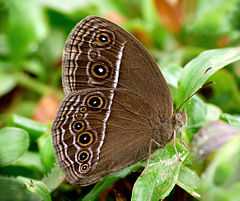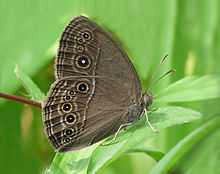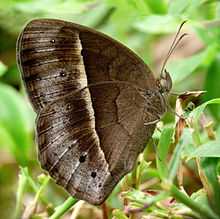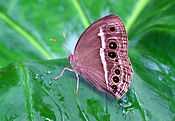Mycalesis perseus
| Dingy Bushbrown | |
|---|---|
 | |
| Wet-season form. Photographed in August 2007. Maredumilli reserve, Rajahmundry district, Andhra Pradesh. | |
| Conservation status | |
| Not evaluated (IUCN 2.3) | |
| Scientific classification | |
| Kingdom: | Animalia |
| Phylum: | Arthropoda |
| Class: | Insecta |
| Order: | Lepidoptera |
| Family: | Nymphalidae |
| Tribe: | Elymniini |
| Genus: | Mycalesis |
| Species: | M. perseus |
| Binomial name | |
| Mycalesis perseus (Fabricius, 1775) | |
The Dingy Bushbrown or Common Bushbrown (Mycalesis perseus) is a species of satyrine butterfly found in South Asia and Southeast Asia.
Description
.
Wet-season form. Male and female. Upperside dark to somewhat pale vandyke-brown. Fore wing with a white-centred, fulvous-ringed, black ocellus in interspace 2, and rarely a very small but similar ocellus in interspace 5. Hind wing uniform, occasionally two or three postmedian obscure ocelli present. Fore and hind wings with subterminal and terminal pale lines. Underside: the groundcolour, subterminal and terminal lines on the wings as on upper-side, but crossed by a common purplish - white narrow discal fascia. Fore wing with from two to four, hind wing normally with seven ocelli, similar to, but more clearly defined than, the ocelli on the upperside ; on both wings the line of ocelli bordered inwardly and outwardly by sinuous purplish-white lines. On the hind wing only the three posterior ocelli in a straight line, the rest strongly curved outwards. In the female the median or posterior ocellus on the upperside of the fore wing is always larger than in the male.
Dry-season form.- Male and female. Unpperside similar to that in the wet-season form, the median ocellus generally smaller. Underside brown, more or less suffused with purple and irrorated with darker brown minute transverse strigae; the transverse discal band obscure, often merely indicated by black dots at the veins, occasionally bordered outwardly by an ochraceous diffuse band. Ocelli obsolescent, but when present as mere minute dots their arrangement on the hind wing is as in the wet-season form. Antennae, head, thorax and abdomen brown; antennae sometimes cinereous white on the sides with the apex black. Male sex-marks in form 2, but that on the underside of the fore wing small (about 2 into, long) and black.
Expanse 42-54 mm.
Habitat. I have examined specimens from the Himalayas, Kangra to Sikhim and Bhutan; from Bengal, Southern India and Ceylon. This form is fairly common throughout Burma and Tenasserim ; it extends to China and far into the Malayan Subregion.[1]
Gallery
-
_butterfly.jpg)
Mantis eating a Common Bushbrown butterfly
-
-_dry_season_form_W_IMG_4190.jpg)
Dry season form at Narendrapur near Kolkata, West Bengal, India.
-

Wet-season form, in Kolkata, West Bengal. Note variable pattern.
-

Dry season form in Kolkata, West Bengal, India.
-

From above
Footnotes
- ↑ Bingham (1905)
References
- Bingham, C.T. (1905): The Fauna of British India, Including Ceylon and Burma. Lepidoptera, Volume 1


